|
The 15,000 acre piedmont forest of Prince William Forest Park provides excellent habitat for a great diversity of avian species. The park is fortunate enough to have a large unfragmented tract of mature deciduous trees and lots of moving water. This attracts a wide variety of birdlife that can’t be found in many other nearby parks. In addition, park maintenance crews conduct minimal roadside mowing to promote the growth of meadows and grassy areas which provide habitat for many grassland birds. The birds found this park are species that are found in high quality forest habitats. No threatened or endangered birds have been identified in the park. Our national bird, the Bald eagle, flies over the area and sometimes nests here. 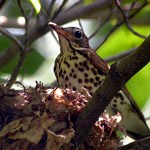
SongbirdsThere are so many species of songbirds that can be heard upon entering our forest in the early morning hours that the forest sometimes seems to sing. First you may be greeted by the loud "teacher-teacher-teacher" of the overnbird or the whistling high-pitched song of the warbler. Many claim that the song of the wood thrush is their favorite. Perhaps the soft "zsee-zsee" and daper coloration of a cedar waxwing eating winter berries will brighten your day. Listen to the sounds of the songbirds. 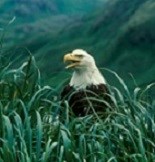
Bald EagleThe Bald eagle is the only eagle unique to North America making it a good choice for the United States' national emblem. They are opportunistic feeders that prefer fish, but will also hunt large birds and mammals. They well as scavenge carrion. They nest in large trees near large bodies of water that are often reused over many years. The use of the pesticide DDT in the second half of the 20th century had a devastating effect on Bald eagles. Extinction loomed. Population numbers increased with help from reintroduction programs and protection under the Endangered Species Act. In 1995, the Bald eagle was reclassified as Threatened. Now, the species is recovered and no longer on the list. 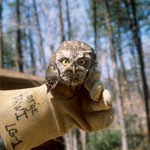
Barred OwlThe Barred owl is a nocturnal bird that hides in dense foliage or in a tree cavity during the day and hunts from a perch at night. They prey mainly upon small mammals, but is an opportunistic hunter and will take various other prey including birds, amphibians, reptiles, and invertebrates such as crayfish. They are known for its distinctive call that is sounds like "who-cooks-for-you, who-cooks-for-you-all". An owl's eyes are fixed in place because their large size provides no room for muscles. To compensate for this, it can turn its head in almost any direction and angle, including the ability to rotate its head nearly 280 degrees. By comparison, people can only turn their heads a mere 90 degrees. Another resident of Prince William Forest Park, the Great Horned owl, is their only natural predator. Barred Owls will avoid areas where Great Horned owls are present. 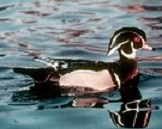
Wood DuckThe wood duck is considered one of the most beautiful waterfowl. They are found in forested wetlands and along rivers, streams, lakes, and ponds. After hatching, the young jump from the nest cavity and make their way to the water where their mother calls to them. The leap from the nest may be as high as 290 feet. They have a broad diet of seeds, fruits, acorns, and aquatic and terrestrial invertebrates. They are one of only a few cavity nesting ducks in North America. Nests in natural tree cavities, cavities, cavities made by larger woodpeckers such as the pileated woodpecker, and man-made nest boxes often in close proximity to water. The nest is lined with down feathers from the mother's breast. 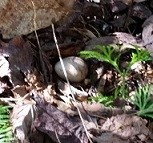
American WoodcockUnlike other shorebirds, the American woodcock prefers habitat consisting of forests with open areas. They are encountered most often at dusk in spring while males are performing their elaborate aerial display in an attempt to attract females. The displays are carried out in open areas where the male begins with a series "peent" vocalizations. Eventually, the male will take flight, rising upward in a spiral, before descending in a zig-zag diving motion. During this descent, a twittering sound is produced both vocally and by air passing over modified with feathers. Their diet mostly consists of earthworms and other invertebrates that are acquired by probing the dirt and leaf litter with their bill. The bill has a sensitive flexible tip that is used to locate and grasp worms and other food items without opening its entire bill. Their nests are nothing more than a shallow depression in the ground. 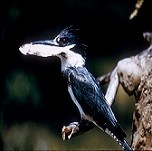
Belted KingfisherThe belted kingfisher is one of only a few bird species where the female is the more colorful of the two sexes. They are found along streams, rivers, and lakes. They eat mostly small fish but also consume aquatic insects, amphibians, reptiles, and crustaceans. They look for prey while perched or hovering over clear water, and then dives head first into water to catch prey with its bill. The Belted Kingfisher will often kill prey by beating it against a branch. The nest in burrows in banks along waterways in which both parents excavate the tunnel, incubate, and feed the young. They often give a loud rattling cry making them sometimes easy to detect. 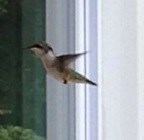
HummingbirdThe hummingbird eats flower nectar, small insects, spiders and sap. They use their long extendable tongue to feed from flowers and feeders. They may consume up to twice their body weight each day. All hummingbirds have a unique figure eight motion of wings during flight that enables them to hover and fly forward, backward, sideways, down, up, and even upside down for brief periods. During flight, the hummingbird beats its wing around 50 times a second and is able to reach speeds of 60 miles per hour. When deprived of food or confronted with cold temperatures, hummingbirds are able to almost completely put body functions on hold and enter a state known as torpor. During this state, they are able to reduce their body temperature to 55°F from the normal 104°F to 111°F. They have very small feet that inhibit them from walking. 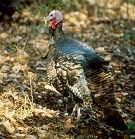
Wild TurkeyThe wild turkey is the largest of the upland game bird species. They were nearly eradicated by the early 1900s due to hunting and habitat loss. Reintroduction programs helped to bring the wild turkey population back to a healthy size. They are found in hardwood and pine forest with scattered openings. During the day, they forage along the ground for acorns, nuts, seeds, fruits, vegetation, insects, and occasionally small vertebrates such as salamanders. Adult males, called gobblers or toms, are much larger than females, have a long beard made a modified feathers growing out of breast, spurs on the back of their legs, and a bare white, blue, and red head and neck. During the breeding season, toms gobble to announce their presence to females and other males. The gobble can be heard up to a mile away. 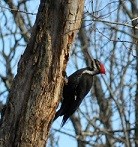
Pileated WoodpeckerThe Pileated Woodpecker is the largest woodpecker in most of North America with the exception of the rare Ivory-billed Woodpecker. They live in deciduous and coniferous forests with large trees and excavates large nests in cavities of generally dead trees. They usually excavate a new nest each year, creating habitat for other large cavity nesters such as Eastern Screech Owls, Northern Flickers, and Wood Ducks. While foraging for food, Pileated Woodpeckers often cut out large rectangular holes in trees. Small trees can sometimes break in half as a result of these foraging practices. Woodpeckers have stiff tail feathers that act as a brace while they cling to sides of trees and a long barbed, sticky tongue to help capture prey deep inside crevices and tunnels in wood. 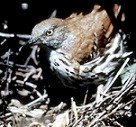
Brown ThrasherThe Brown Thrasher is able to mimic up to 3,000 different songs. Other members of the Thrasher family which are also found here at Prince William Forest Park including the Northern Mockingbird and the Gray Catbird. They search for insects by using its bill to sweep leaf litter and debris away. They nest on or close to the ground in dense vegetation often with thorns. Both parents incubate the eggs and feed the young. The Brown Thrasher aggressively defends its nest and has been known to strike people and dogs with enough force to draw blood. 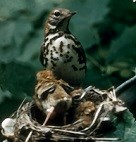
Wood ThrushPeople who know and love bird songs often claim that the wood thrush's song is their favorite. Indeed it does possess all the qualities of the classic and traditional "bird song". The wood thrush's song is flute like, flowing, musical and comparatively long. But you do not have to go just by song to identify a wood thrush. They are fairly easy to spot, being very active and robin sized rather than tiny like so many of our other birds. They will be seen flying about in the low to middle canopy and singing during dawn and dusk hours. They do like to stay sheltered and won't often be seen out in the open. 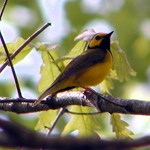
Hooded WarblerThis little beauty is the gem of our woods. A bright dash of vibrant yellow lights up the forest when a hooded warbler flits by. An olive colored back, and yellow face and belly grace the body of this tiny warbler. But it's the black 'hood' over its head that gives them their common name. The female is a lighter version of the male with a less distinct hood. It can be quite frustrating trying to find a hooded warbler. You may hear his whistling high-pitched song close by, but never see that gorgeous plumage. But with some patience you may catch a glimpse, because "hoodeds' don't constantly dwell in the upper canopy like most other warblers. They can be spotted in the mid canopy, but never sit still for very long. 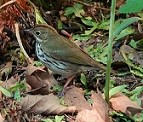
OvenbirdThis bird is actually one of our more common wood warblers. His song is so loud and frequent that it can drown out the softer songs of the other birds. He is often seen low in the leaf canopy, or on the ground walking rather than hopping. He is a soft brown and has a white chest with brown spots. His head bears a darker rusty colored stripe. you may hear his call so often that by the time a one hour hike is over, you will have learned his song, committing it to memory. Male and female ovenbirds have similar plumage. 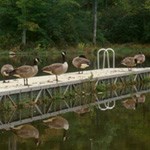
WaterbirdsDown by the water, kingfishers and great-blue herons as well as Canada geese may be surprised by your appearance on the trail, flushing up into the air before returning to earth further upstream. 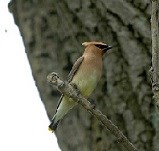
Cedar WaxwingThe cedar waxwing is one of few bird species in North America that specializes in eating fruits and berries. They are named for waxy red "droplets" on the tips of secondary flight feathers and their affinity for the fruit of the eastern red-cedar. The "droplets" come from pigments in the fruit that they consume. Humans have also affected the cedar waxwing's coloration. They have been observed with orange tail tips rather than the normal yellow tail tips. This is a result of a red pigment of te berries of an introduced honeysuckle plant. If a waxwing eats the berries while molting its tail feathers, the tip of the feather will be orange. Feel free to e-mail us for more information on our birds or to report an exciting siting. |
Last updated: July 17, 2022
